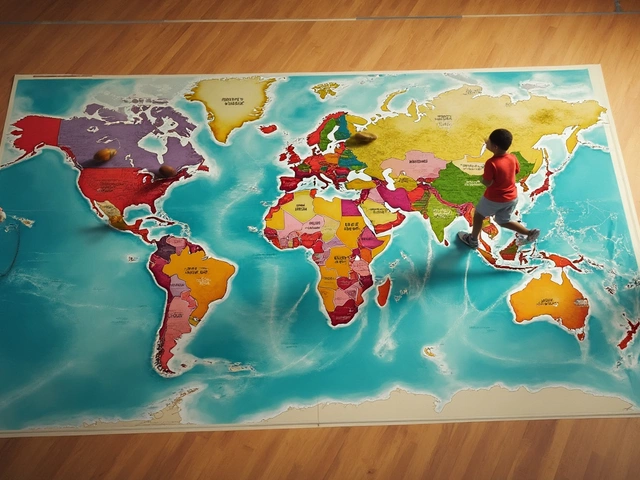
Cycling February 4, 2025
Why Google Maps Is Missing the Bicycle Option
Google Maps has long been a staple for anyone in need of navigation, offering detailed routes for drivers and walkers alike. Yet, for those of us who prefer pedals over gas pedals, the lack of a dedicated bicycle option can be a head-scratcher. The truth is, the absence of this feature isn't due to neglect but rather a result of the intricate nuances of cycling itself.
Cycling routes demand careful consideration of diverse factors, from road conditions to altitude changes, which aren't as critical when mapping out car journeys. However, this gap doesn't mean cyclists are left directionless. The digital world brims with solutions tailored for the two-wheeled adventurer.
Join me as we delve into why Google Maps has yet to embrace the bicycle fully, and more importantly, explore the tools and technologies eager to guide every cyclist safely and effectively to their destination.
- The Evolution of Google Maps
- Cycling Needs vs. Mapping Capabilities
- Why the Bicycle Option is Missing
- Alternative Solutions for Cyclists
- The Future of Cycling Navigation
The Evolution of Google Maps
Since its inception in 2005, Google Maps has transformed the way we navigate the world. What began as a simple wayfinder for motorists has evolved into a multi-faceted tool used by millions daily. Initially, it offered basic driving directions, but it didn't take long for developers to realize its potential, leading to significant expansions in features and capabilities.
One of the first major enhancements was the introduction of walking directions in 2008, acknowledging the need for pedestrian-friendly mapping. This feature redefined urban exploration by accounting for footpaths and pedestrian zones, previously ignored in standard vehicular maps. With the increasing popularity of Google Maps, came Street View in 2007, allowing users to virtually explore locations as if they were there themselves, providing an immersive experience that was unparalleled at the time.
A game-changer came in 2009 with the integration of public transit data. By partnering with transit agencies worldwide, like those in London and New York City, Google Maps enabled users to seamlessly plan journeys involving multiple modes of transport, underscoring its commitment to holistic navigation.
Integration and Innovation
Perhaps the most striking advances occurred with the shift towards real-time data integration. By pulling live information from GPS-enabled devices and geographical data feeds, Google Maps began offering route suggestions based on current traffic conditions. The magic of predictive analytics became evident as commuters received notifications on delays and alternative routes in real time.
The Rise of Mobile and Customization
With the surge in smartphone usage, the mobile app became a crucial focus. Google Maps seized the opportunity by offering features like offline maps for data-saving excursions and personalized journey suggestions based on user behavior patterns. The impact was further boosted by integrating location-based services, aiding businesses and tourists alike.
Yet, despite these advancements, the absence of a dedicated cycling routes option continues to perplex many. As urban commuting shifts towards sustainability, the need for tailored solutions for cyclists in Google Maps becomes increasingly apparent.
While we acknowledge the remarkable journey of Google Maps, we must also consider the path forward. As our transportation preferences evolve, so too must our mapping technologies. Could an integrated approach to bicycle navigation be on the horizon? The possibilities are as dynamic as the roads we travel.
Cycling Needs vs. Mapping Capabilities
Navigating on two wheels brings its own unique set of requirements and challenges. Unlike cars that rely on roads, cyclists often favor bike paths and lanes, which can be sporadically mapped and maintained, varying significantly even within the same city. This demands a tailored navigation approach, one that Google Maps, with its traditional focus on roadways for cars, hasn't fully integrated yet.
Understanding Cyclist Preferences
Cyclists seek routes that offer safety, speed, and scenic beauty. They might be eager to avoid steep hills, busy intersections, or roads without dedicated bike paths. Balancing these factors is not just a matter of overlaying bike-friendly paths onto existing maps. It requires keen understanding of local cycling culture and habits, aspects that might be missing from algorithm-driven mapping software.
The Data Challenge
Creating a reliable bicycle navigation system is not simply about mapping out existing bike lanes. It involves gathering market-specific data on topography, current traffic conditions, and even weather which affects riding preferences. For instance, a route that's perfect on a sunny day might become perilous in rain or snow. These conditions require dynamic mapping capabilities that adapt not only to geographical intricacies but also to changing environments.
The Role of Technology
Technological advancements could bridge the gap to some extent. However, the challenge remains in curating and updating the vast amount of data necessary to accurately reflect safe and efficient cycling routes. This high data demand might explain why Google Maps has not yet adopted a comprehensive bicycle navigation feature.
What Cyclists Want vs. What Maps Provide
A survey conducted by a cycling community revealed that approximately 68% of cyclists expressed dissatisfaction with current mapping solutions, citing a lack of features such as real-time elevation data and traffic alerts. Cyclists desire an experience that echoes their priorities in safety and efficiency, something current map solutions struggle to deliver.
For Google to truly incorporate these needs, it would require sophisticated data analytics and machine learning capabilities to anticipate and include cycling-specific conditions, seamlessly integrating them into existing navigation systems.

Why the Bicycle Option is Missing
It's fascinating to consider why a tech giant like Google, renowned for its innovation and user-centric solutions, hasn't yet integrated a bicycle navigation option within its popular Google Maps application. One might ponder, in an age where cycling is acclaimed for its environmental and health benefits, how such a void persists.
The Complexity of Cycling Data
A significant factor lies in the inherent complexity of cycling data. Unlike driving, cycling routes vary drastically based on a multitude of factors including bike paths, road hazards, altitude changes, and even weather conditions. These variables demand a level of granularity in mapping that exceeds the usual parameters for vehicles. The intricacies of metropolitan cycling paths, often weaving through parks and pedestrian areas, make data collection and maintenance extraordinarily labor-intensive.
Varied User Preferences
Cyclists' preferences further complicate the matter. Some cyclists prioritize speed, seeking out the fastest routes which may parallel car routes, while others might prefer the scenic or the safest path – potentially avoiding busy roads entirely. Such variability demands a customizable solution that Google Maps hasn’t developed as of yet. In contrast, car and pedestrian routes are much more straightforward, focusing primarily on efficiency and directness.
Technical and Economic Challenges
Developing and maintaining a reliable bicycle navigation system also presents technical and economic challenges. The required infrastructure to collect and update high-quality cycling data globally is substantial. From a business standpoint, this investment must be balanced against user demand, which, while growing, still remains a niche compared to car or transit users.
Indeed, Google Maps does offer limited support for bikes in certain regions, but the inconsistency across the globe highlights the difficulty of creating a universal solution that fulfills all cyclists' needs.
Imperfect Solutions and Competitor Insights
Several competitors in the digital mapping field are dedicated exclusively to cycling, providing more nuanced solutions. Still, they too wrestle with similar challenges. Despite this, applications like Strava and Komoot have forged paths that demonstrate the demand and potential for these technologies, pushing large platforms like Google to reevaluate their offerings.
The landscape of cycling navigation is evolving, no doubt propelled by urban policies that emphasize eco-friendly transport modes. The question remains whether Google will rise to meet this demand or if specialized apps will continue to fill the gap.
Alternative Solutions for Cyclists
While Google Maps might have temporarily sidelined the bicycle option, there's no shortage of digital tools poised to assist the modern cyclist. With the increasing popularity of cycling, developers have created myriad applications specifically tailored to meet the needs of those who embrace the gentler, greener mode of transport.
Dedicated Cycling Apps
Several applications have emerged, focusing solely on cycling. Notably, Strava, initially made for athletes, has become a favorite among cyclists. The app not only tracks performance but has a vibrant community where routes are shared and cyclists can compare times with each other in segments known as 'Strava Segments.'
Another excellent option is Komoot, which shines in route planning and navigation. What sets it apart is its ability to recommend paths based on users' preferences—be it a leisurely ride on paved roads or an off-road adventure. It even provides insights on path conditions and elevation.
OpenSource Mapping Solutions
If you prefer a more collaborative approach, OpenStreetMap (OSM) might be the ideal platform. It’s a crowd-sourced map where cyclists can contribute their favorite routes. The beauty of OSM lies in its adaptability, offering up-to-the-minute route information in some areas.
Community-Focused Platforms
Inclusivity and personalization are key in cycling communities. Forums and platforms like Bikemap allow cyclists to share their local knowledge, generating a treasure trove of tried-and-tested routes. Engaging in such communities not only provides practical routes but also enriches the cycling experience through shared stories and tips.
Comparison of Features
| App | Route Suggestion | Community Features | Offline Maps |
|---|---|---|---|
| Strava | Yes | Strong | No |
| Komoot | Excellent | Moderate | Yes |
| Bikemap | Good | Strong | Yes |
For those yearning for the thrill of new trails or the serenity of quiet paths, these digital companions provide an excellent means to navigate the world by bicycle, fulfilling the gap left by Google Maps.

The Future of Cycling Navigation
In a world that's increasingly steering towards greener solutions, cycling is taking center stage as a viable and preferred mode of transport. As cities aim to pedal forward into a sustainable future, the demand for reliable cycling routes is more pressing than ever. But what does the future hold for cycling navigation, and how can we expect technological advances to change the way we bike across town or even country?
Integrating Artificial Intelligence
The incorporation of AI into navigation is already changing the landscape for cyclists. Smartphones and smart bike accessories can leverage AI to adapt routes in real-time. These technologies consider live traffic patterns, roadworks, and even crowd-sourced data from fellow cyclists. As AI continues to develop, it will likely offer unparalleled personalization, ensuring that every ride is efficient and safe.
Smart Cities and Infrastructure
Many cities are investing in smart infrastructure that supports cycling navigation. This includes internet-connected traffic signals and dedicated cycling lanes equipped with sensors to monitor bike flow and safety. Imagine a city where intersections 'speak' to your bike, advising you to slow down due to congestion ahead, or signaling a safe left turn based on your speed.
Data-Driven Route Optimization
As the Internet of Things (IoT) becomes more embedded in our transportation systems, the amount of data available for optimizing cycling routes is exploding. This is paving the way for navigation apps to deliver more accurate and context-aware routes that factor in your typical cycling speed, preferred terrain type, and even weather conditions.
Augmented Reality (AR) in Cycling
The introduction of AR in navigation holds promising prospects. AR-equipped eyewear or helmet displays could overlay directions directly onto your view, highlighting upcoming turns or hazards without the need to glance down at a smartphone. This technology not only makes navigation more intuitive but also significantly enhances safety by ensuring that a cyclist's eyes are firmly on the road.
Community and Crowd-Sourced Enhancements
The future of cycling navigation will undoubtedly benefit from the cycling community itself. Applications that allow cyclists to share real-time updates about route conditions or new paths are already gaining popularity. As more cyclists contribute, the collective knowledge grows, making these apps ever more reliable and dynamic.
It's clear the horizon is bright for cycling enthusiasts. With the ongoing technological advancements, the days of clunky map unfolding and guessing games will be replaced by seamless, intuitive cycling navigation solutions tailor-made for our two-wheeled adventures.




